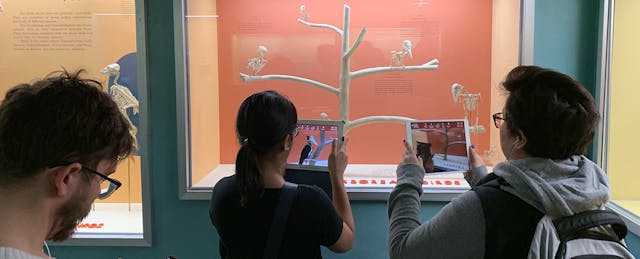This semester I’m teaching a graduate seminar on education and technology for Georgetown University. Over the next two months, I’ll share the experience and highlights in a series of columns for EdSurge with highlights from the course. This is part 4. Read part 1, part 2 (about audio) and part 3 (about video).
How does higher education use mobile technology to teach?
The edtech seminar I'm teaching this semester recently explored the post-desktop world, and to get students thinking about the differences, I began with a quick exercise, asking them to rearrange the classroom into old-school rows.
Normally our room is a progressive space, with all furniture on wheels, plenty of charging stations available, and multiple mobile screens (such as interactive whiteboards and screens reserved for videoconferencing). It has no established center, and students were used to learning and working in that nonhierarchical, flexible space.
Being thrown back into rows was like a historical reenactment, and not in a pleasant way.
Immediately they said they felt confined and isolated from their peers. Old habits returned, like slouching and raising their hands. They all felt compelled to direct their attention away from their classmates and towards the front of the room, eyes focused not on their laptops but on the instructor (me) and the main screen I projected. Hierarchy reasserted itself. When I ended the exercise and allowed them to reconfigure the space they were delighted–and had a new sense of the difference between fixed and mobile learning.
After that shock, discussion began by exploring the full range of mobile technology available in 2019. We identified a broad device ecosystem of laptops, tablets, smartphones fitness trackers, smartwatches, computer-enabled shoes, game players and e-readers, then examined how moving content between those devices was enabled (open standards, the web) or discourages (hardware-specific formats, siloes). And we talked about how the emerging Internet of Things (like Nest thermostats and Alexa assistants) were changing our lives: less dead time, little experience reading maps, fewer uses of paper, more media and more opportunities to learn.
I introduced some historical context, describing how mobile phones swept most of the world in the 1990s as countries leapfrogged telephone networks, while the United States came late to the game, as we had relative fine telephony and ample computing access. The iPhone, Android platform, and Kindle then took America quickly into the mobile universe.
We talked about readings about Mobile Learning, including an essay I published back in 2004 anticipating the mobile future. These days students have continuous access to learning content and peers, depending on infrastructure and social position. They have to learn how to learn autonomously. Indeed, several students argued that mobile devices give students greater scope to shape their learning. Students can capture multiple types of media, then work them into assignments. They can, of course, socialize through mobility, which can support group work and the formation of learning communities.
Of course, these mobile tools have downsides, starting with the temptation of distraction. Social differences drive uneven access to technology, expressing or reinforcing inequities. Privacy can be violated, either by inappropriate media capture or hacking (to which the internet of things is especially vulnerable). Greater abilities to connect socially can lead students to expect faculty members to respond to their queries too quickly (like when they send a text message on aa Saturday night requesting a Sunday morning reply).
Naturally, all of this discussion occurred with the help of mobile devices. Students took notes and hunted references through phones and laptops. I used my laptop to share and take more notes. One student Zoomed in through a mobile screen. We all took turns jotting thoughts on a smartboard, whose contents we exported to our campus email accounts.
We saw other ways for mobile devices to connect with learning.
My students came to class already immersed in the mobile world. While we discussed always-on connectivity, they lived the reality, discussing topics in our LMS, working with each other through tablets, smartphones, and laptops carried all over the Washington, DC area. In fact, the students organized a Sunday class field trip to the Smithsonian National Museum of Natural History so that we could explore an augmented reality exhibit. They wrangled a stack of iPads and iPods for us to use as we toured, and we learned more about animals than we would have without. Then we talked about tech in education among the swarms of other museum visitors.
It was mobile learning in action.


